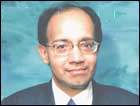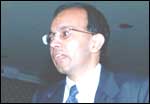Home > Business > Special
The 'affordable computing' dream
Priya Ganapati in Mumbai |
April 25, 2003
Success, fame and $115 million sit lightly on Rajesh Jain's shoulders.
"I don't think about the money. Others do," he says.
 Ask him what fame tastes like and he says he doesn't know. For the last two years, Jain has turned down every interview request that came his way.
Ask him what fame tastes like and he says he doesn't know. For the last two years, Jain has turned down every interview request that came his way.
Probe about the burden of success and he waves you off. "I don't feel any of the pressures of success. I like to do what I am doing based on lot of continuous thinking about the future and how it will evolve. Anyway, success and failure are all part of being an entrepreneur."
The millionaire poster boy
In 1999, Jain became the homegrown poster boy for the dot-com revolution in India when Sify (then called Satyam Infoway) acquired IndiaWorld, a collection of India-centric websites, comprising Samachar, Khel, Khoj and Bawarchi in November 1999 for $115 million.
The astounding deal fed the dreams of hundreds of Internet entrepreneurs and gave the local spark to the dot-com frenzy.
Yet, Jain remained remarkably untouched by it. His decision to stay away from the media, ensured that he faded off the radar pretty soon.
After selling IndiaWorld, he made a smooth transition to Sify where he helped integrate IndiaWorld with Satyam's existing portal. He worked on expansion plans for the new Sify site and then two years later quit to be on his own.
Life in the interim did not change much, he says. The $115 million in the bank did not transform his lifestyle. He has only upgraded his car, but to a model in the same price range. And he still uses one of his older mobile phones, while his office is free of any interesting gizmos.
"Money was never a motivation for me. After IndiaWorld, it (money) was important only to the extent that it was a vindication of my efforts and the value that someone saw in it. Nothing has changed for me. I still come to work everyday like I have for the last ten years," he says.
The Netcore initiative
Work for him, at the moment, is managing Netcore Solutions, even as he is trying to flesh out ideas that can bring computing to rural India.
The first of his ventures, Netcore Solutions, has been around for a while: precisely, five years. Jain started it in 1997, two years after IndiaWorld was up and struggling to find its niche.
Eager to spread out his risk then, he was experimenting with different ventures and Netcore was started as a company that would offer messaging solutions to small and medium enterprises.
"Netcore came out of the work we used to do for companies, building their Web sites in 1995-96. Most of the companies didn't know how to handle their e-mail so we decided to take on that too and thus Netcore's messaging solutions were developed," says Jain.
Today Netcore has over 200 clients and offers Jain a steady revenue stream, but not the promise of rapidly escalating growth and returns.
"It's a sunny, commoditised business," agrees Jain.
To expand Netcore, naturally, it would be necessary to expand the user base, to at least 100 million users or so, he thought.
Affordable computing; cheaper computers
But that kind of explosion would not come from just the cities in India. Computing would have to be taken to rural India for the market to grow around, where none exists today.
The first step towards that would be to ensure that cheaper computers are available.
"More than the problem of making available low-cost software is that most people don't have the hardware. So, these two problems merged together and that's where the ideas for affordable computing emerged. What is required is to bring down the cost of software and hardware both. You cannot have a solution for just one of the two," says Jain.
Jain then came up with what he calls the 'three Ls' of his vision of taking computing to the masses: low cost computer, Linux and localisation.
To this mixture, he adds the idea of server-centric computing and he has his recipe to bring computing to rural India ready.
Each of the 'Ls' requires working on, though. Today, personal computers are available at around Rs 20,000, while Linux still is to find widespread acceptance among developers and buyers and software in local languages is still not available widely.
Jain wants to tackle every part of this problem. And that requires him to first find an alternative to high-cost personal computers that are available today.
Getting there
His solution is to use old or refurbished computers that could be made available at price-points of Rs 5,000 and Rs 7,500 and use server-centric computing so that these computers would just be 'think clients.'
 "Computers and monitors do not go bad in 3-4 years, which is the typical upgrade cycle in the developed world. They can easily be used for many more years, provided the processing and storage can be moved to the server. The thin clients become graphical terminals -- or more appropriately, PC terminals," says Jain.
"Computers and monitors do not go bad in 3-4 years, which is the typical upgrade cycle in the developed world. They can easily be used for many more years, provided the processing and storage can be moved to the server. The thin clients become graphical terminals -- or more appropriately, PC terminals," says Jain.
The other approach, he contemplates, is to use computers with the VIA chipset and motherboard. VIA is the third company after Intel and AMD that makes x86-compatible CPUs. Their cheaper, lower-speed CPUs bring down the cost of the client, making it possible to get a new computer (excluding the monitor) for prices as low as Rs 6,500, which can be coupled with an old monitor that costs about Rs 2,000.
Combine these low cost PCs with server-centric computing and open source software and you have all the ingredients for creating a computing infrastructure in the villages. Jain has a name for it: TeleInfoCenters.
A TeleInfoCentre would be a computer-cum-communications centre. It would have 3-5 computers connected together in a LAN, in a single room. One of the computers would work as a 'thick server' and do the processing and storage. The others are low-cost, low-configuration 'thin clients.'
"By locating them in the village, we ensure that people do not have to walk too much to use them: access to computing is just a few minutes, rather than a few kilometers, away. This will make them think of computing as part of their lives; a utility, available on-demand," says Jain.
The TeleInfoCentre would largely work in the offline mode. The server should mirror key applications and relevant data, making it possible for the clients to work without the need for an Internet connection. Updates could be done via CDs or even Wi-Fi (wireless connectivity).
Such radical thinking is what is necessary to bring computing to rural India, says Jain.
Where will funds come from?
Over the last few months he has been working the phone to reach out to IT secretaries in various state governments, travelling to villages to see how computers really work and reading fanatically to see how similar projects have been implemented in other countries.
Jain is clear that the impetus and funding for the TeleInfoCenters has to come from the government.
"The government is an integral part of people's lives in rural areas. They key to the success of this idea is to have the state governments take the lead," he says.
Putting up a TeleInfoCentre in each village of India, which would approximate to about 600,000 villages, would cost an estimated Rs 7,000 crore (Rs 70 billion). These kind of deep pockets could only exist in the government.
But getting fresh allocations would involve navigating a bureaucratic maze that could stall the idea for years and push it into oblivion.
Instead, Jain suggests that the government should use existing allocations to build the TeleInfoCentres as they would also help in achieving education, self-sufficiency and goals for small businesses that have been already set.
"There are various schemes in India like the Sarva Shiksha Abhiyan, which has for instance a budget of Rs 25,000 crore (Rs 250 billion). On roads we are willing to spend Rs 150,000 crore (Rs 1,500). The problem is every government department thinks in its own silo," he says.
Part of his efforts may be paying off. A few weeks ago, he visited a few villages in Madhya Pradesh, a state he declares as the most 'proactive' in bringing computing to the masses.
Out of the 52,000 villages in Madhya Pradesh, 2,700 already have a centre with three computers that are being used for education.
Jain is trying to convince the state government to transform these into TeleInfoCenters that could be used for applications that can be categorised into information (commodity prices, weather information, crop planning, literacy programmes, exam results, health information, school curriculum, government notifications, downloadable forms which could either be printed or filled online, and employment opportunities); communication (e-mail, voice-over-Internet protocol); community (interaction between similar service providers across different villages); and transactions (land records and birth/marriage/death certificates).
But critical right now is to get a pilot project running that would not only embody his vision but also vindicate it.
It is only when the venture succeeds in one state can others be convinced to go for it.
There are many questions that Jain admits he does not know the answer to right now.
How will the supply chain for these low cost computers be created? Who will make them? How will the applications to run on these computers be developed? Will other state governments be open to the plan? If the government cannot pay up completely, where will the funding for the TeleInfoCenters come from?
"I don't have the answers to all the questions yet. I know we will do it in next 6-8 months. My approach is to try multiple things. Some may work, some may not. But the important thing is to try and I know we are heading in the right direction," he says.